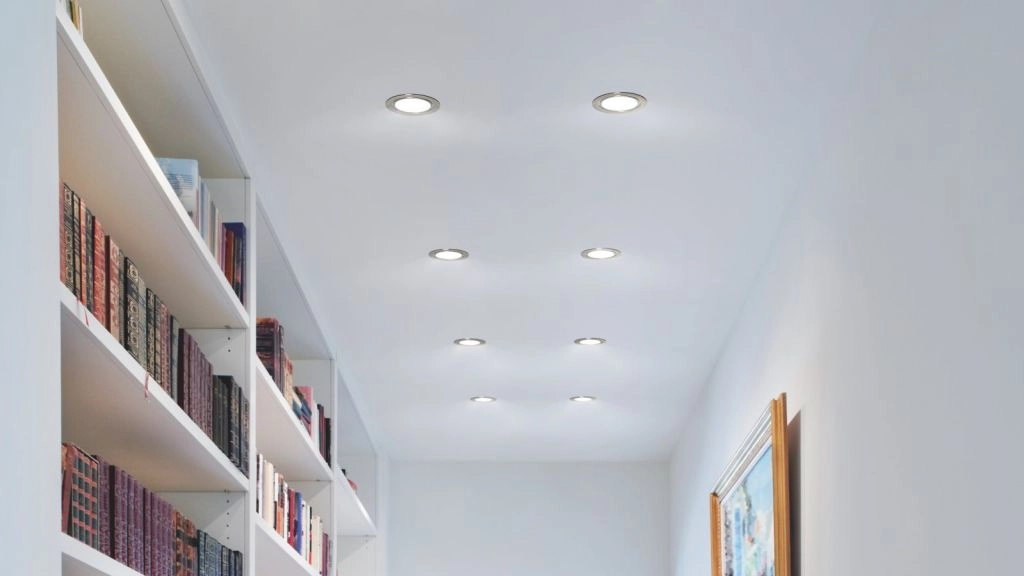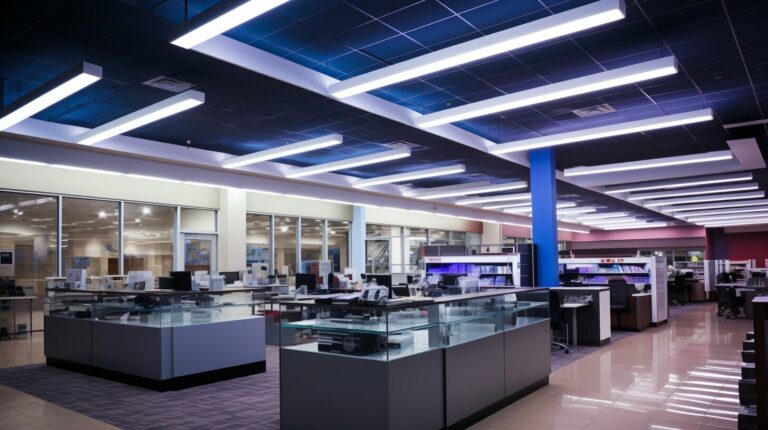Introduction
In the dynamic world of interior design and home improvement, few elements have made as significant an impact as LED downlights. These sleek, energy-efficient lighting solutions have rapidly become a favorite in modern homes, effortlessly blending functionality with aesthetics. But why has there been such a buzz around them? And more importantly, with the myriad of options available, how can one ensure they’re choosing the right LED downlight for their space?
This guide aims to shed light (pun intended!) on the world of LED downlights, offering insights into their rise in popularity and the undeniable benefits they bring. Whether you’re renovating, building from scratch, or simply looking to upgrade your current lighting, understanding the nuances of LED downlights can make all the difference in achieving the ambiance you desire. So, let’s dive in and illuminate the path to making the best lighting choices for your home!
Understanding the Basics of LED Downlights
When we talk about LED downlights, we’re delving into a world where technology meets design. But before we get too deep into the intricacies, let’s break down the basics.
What are LED downlights?
LED downlights are a type of light fixture that’s installed into a hollow opening in a ceiling, emitting light in a downward direction. The “LED” in LED downlights stands for Light Emitting Diode, which is a semiconductor light source that glows when an electric current passes through it.
The science behind LED lighting
Traditional bulbs produce light by heating a filament, which not only consumes more energy but also reduces the lifespan of the bulb. In contrast, LEDs create light through electroluminescence, a process where electric current passes through a semiconductor (or diode). This method is far more energy-efficient and ensures the LED lasts longer.
Benefits of choosing LED over traditional lighting
There’s a reason homeowners and designers are flocking to LEDs. Not only do they consume less power, reducing electricity bills, but they also have a longer lifespan, often lasting up to 25 times longer than their incandescent counterparts. Additionally, with LEDs, there’s no waiting time for them to reach their full brightness, and they offer a broader range of color temperatures, allowing for more flexibility in creating the desired ambiance.
In essence, understanding the basics of LED downlights is the first step in appreciating their value. As we delve deeper into this guide, you’ll discover how these foundational principles play a role in the broader context of home lighting.
Factors to Consider When Choosing LED Downlights
Selecting the perfect LED downlight isn’t just about picking the first shiny fixture you see on the shelf. It’s about understanding your space, your needs, and the myriad of factors that come into play. Let’s break down the essentials to consider.
Room purpose and ambiance goals
Every room has a purpose, and the lighting should complement that. A kitchen might require brighter, more direct lighting for cooking, while a bedroom might benefit from softer, ambient lights. Consider the primary activities in each room and how your lighting can enhance them.
Size and depth of the space
The size of your room can influence the number of downlights you need and their placement. Larger rooms might require more fixtures or higher lumen outputs, while smaller spaces might need fewer downlights strategically placed.
Color temperature preferences: Warm vs. Cool
LEDs offer a range of color temperatures, from warm yellows reminiscent of sunset hues to cool blues mirroring daylight. Your choice here can drastically affect the mood of a room. Warm lights often create a cozy, relaxed atmosphere, while cooler lights are energizing and crisp.
Lumen output: How bright is bright enough?
Lumens measure the brightness of a light. While it’s easy to think “the brighter, the better,” sometimes subtlety is key. A reading nook might benefit from a higher lumen output, ensuring clarity, while a dining area might be better with softer lighting to set the mood.
In the grand scheme of home design, lighting is a pivotal player. By considering these factors, you ensure that your LED downlights not only look good but also function perfectly, enhancing every moment spent in that space.
The Different Types of LED Downlights
Venturing into the world of LED downlights, you’ll quickly realize there’s a diverse array of options available. Each type has its unique features, benefits, and ideal use cases. Let’s demystify the choices and help you find the perfect fit for your space.
Fixed vs. adjustable downlights
Fixed downlights, as the name suggests, shine directly downward in a fixed position. They’re great for general room lighting. On the other hand, adjustable downlights can be tilted to direct light at specific angles, making them ideal for accent lighting or highlighting specific areas or features in a room.
Recessed vs. surface-mounted options
Recessed downlights are installed so that they sit flush with the ceiling, offering a sleek and minimalist look. They’re especially popular in modern homes. Surface-mounted downlights, however, protrude slightly from the ceiling. They’re versatile and can be a design choice or a practical solution for ceilings where recessing isn’t possible.
Spotlight vs. floodlight: The beam angle debate
The beam angle determines how light is dispersed from the fixture. Spotlights have a narrow beam, focusing light on specific areas – think of art displays or bookshelves. Floodlights, with their wider beam angle, are used for more general, ambient lighting.
Dimmable options for mood setting
Some LED downlights come with dimmable features, allowing you to adjust the brightness as per your mood or the time of day. This feature is especially handy in multifunctional spaces where lighting needs can vary.
Choosing the right type of LED downlight can feel like a daunting task, but with a clear understanding of the options and your specific needs, you’re well on your way to making an informed decision. Remember, it’s all about blending functionality with aesthetics to create the perfect ambiance.
The Importance of Energy Efficiency
In today’s world, where sustainability and energy conservation are at the forefront of many discussions, LED downlights shine bright as a beacon of hope. But what makes them such a standout choice in the realm of energy efficiency? Let’s dive deeper.
How LED downlights save on electricity bills
Traditional lighting solutions, like incandescent bulbs, waste a lot of energy in the form of heat. LED downlights, on the other hand, convert a higher percentage of energy into light, ensuring less wastage and, consequently, reduced electricity bills. Over time, the savings can be substantial.
The environmental impact of LED lighting
Beyond just the savings on your monthly bills, there’s a broader, global perspective to consider. LEDs have a smaller carbon footprint. By consuming less power, they reduce greenhouse gas emissions, playing a part in combating climate change. Plus, with a longer lifespan, there’s less frequent replacement, leading to reduced waste.
Longevity and durability: Getting the most from your LED
It’s not uncommon for LED downlights to last up to 25,000 hours or even more. Compare that to the 1,000-hour average of incandescent bulbs, and the benefits are clear. This longevity means fewer replacements, less hassle, and more savings in the long run.
The role of certifications and ratings
When shopping for LED downlights, you might come across various certifications or energy ratings. These are indicators of the product’s energy efficiency and can be a helpful guide in choosing the best options. Look for recognized certifications to ensure you’re getting a genuinely energy-efficient product.
Incorporating energy-efficient solutions like LED downlights is more than just a trend; it’s a step towards a more sustainable and responsible future. By understanding the importance of energy efficiency in your lighting choices, you’re not only benefiting your home but also making a positive impact on the planet.
Safety and Installation Tips
While LED downlights come with a plethora of benefits, ensuring they’re safely installed and maintained is paramount. After all, even the most stylish lighting won’t be worth much if it poses safety risks. Let’s explore some key considerations and tips for a smooth, safe installation process.
The right way to install LED downlights
While many DIY enthusiasts might be tempted to install their downlights, it’s often recommended to hire a professional, especially if you’re unfamiliar with electrical work. A professional will ensure that the wiring is correct, fixtures are securely in place, and the overall setup is safe.
Common installation mistakes to avoid
- Overloading circuits: Ensure you don’t have too many lights on a single circuit, which can lead to overheating.
- Incorrect spacing: Downlights should be spaced appropriately to provide even illumination and prevent dark spots.
- Ignoring insulation: If your ceiling has insulation, ensure it doesn’t cover the downlights, as this can be a fire hazard.
Safety precautions for a worry-free experience
- Always turn off the electricity at the main switch before starting any installation.
- Use downlights with the appropriate IP rating for areas exposed to moisture, like bathrooms.
- Ensure there’s adequate ventilation around each downlight, especially if they’re being installed in a tight space.
Maintaining your LED downlights
While LEDs are known for their longevity, occasional maintenance can further extend their life. Regularly dusting the fixtures, ensuring they’re free from insects or debris, and checking for any signs of wear or damage can go a long way.
In the end, while LED downlights are a fantastic addition to any space, ensuring they’re installed and maintained safely is crucial. With the right precautions and awareness, you can enjoy their benefits without any worries.
Design and Aesthetics
Lighting, while functional, is also a significant design element in any space. LED downlights, with their sleek profiles and versatile designs, can be a game-changer in setting the tone and ambiance of a room. Let’s delve into the world of design and aesthetics as it pertains to these modern lighting wonders.
Matching LED downlights with room decor
The beauty of LED downlights lies in their adaptability. Whether you’re aiming for a minimalist Scandinavian vibe, a rustic farmhouse look, or a luxurious modern aesthetic, there’s a downlight design to match. Consider the finish, size, and shape of the downlight in relation to the room’s overall decor.
Modern designs and trends in LED downlight fixtures
From ultra-slim profiles to ornate fixtures with artistic flair, the world of LED downlights is ever-evolving. Stay updated with the latest trends, such as smart downlights that can be controlled via apps or voice commands, or designs that incorporate materials like wood or metal for added texture.
Creating mood and ambiance with lighting
The strategic placement of downlights can create various moods. For instance, a series of downlights along a hallway can create a dramatic, runway-like effect, while softer, diffused downlights in a bedroom can evoke a serene, spa-like ambiance.
The role of complementary lighting
While LED downlights are fantastic, they often work best in conjunction with other lighting types. Consider pairing them with pendant lights, wall sconces, or floor lamps to create layers of light, adding depth and dimension to your space.
Incorporating LED downlights isn’t just about brightening a room; it’s about enhancing its design and feel. By giving thought to design and aesthetics, you ensure that your lighting not only serves its functional purpose but also elevates the beauty and ambiance of your space.
Cost Considerations
When it comes to home improvements or renovations, budgeting is often at the forefront of decision-making. While LED downlights offer numerous benefits, understanding their cost implications can help you make an informed choice that aligns with your financial plans.
Initial costs vs. long-term savings
While LED downlights might have a higher upfront cost compared to traditional lighting options, it’s essential to view this as an investment. Their energy efficiency translates to lower electricity bills, and their longer lifespan means fewer replacements over time. Over the years, these savings can significantly offset the initial expenditure.
Where to find budget-friendly yet quality LED downlights
Not all LED downlights are created equal. While it’s tempting to opt for the cheapest option, it’s crucial to ensure you’re not compromising on quality. Look for sales, discounts, or bulk purchase deals from reputable manufacturers. Additionally, reading reviews and seeking recommendations can lead you to quality options that won’t break the bank.
The hidden costs: Installation and maintenance
Remember to factor in installation costs, especially if you’re hiring a professional. While DIY installation might save money upfront, ensure you’re confident in your skills to avoid potential mishaps or future repair costs. As for maintenance, while LEDs are generally low-maintenance, occasional checks and cleaning can incur minimal costs.
Warranty and guarantees: Protecting your investment
A product’s warranty can offer insights into its quality and durability. Opt for LED downlights that come with a robust warranty, ensuring that you’re covered should any issues arise. This not only provides peace of mind but can also lead to cost savings in the unlikely event of product defects.
Budgeting for LED downlights is about more than just looking at the price tag. By considering the long-term benefits, potential savings, and ensuring you’re getting value for your money, you can make a choice that’s both financially sound and aesthetically pleasing.
Reviews and Recommendations
In the age of information, consumer reviews and expert recommendations play a pivotal role in shaping purchasing decisions. When it comes to LED downlights, sifting through these insights can provide clarity, ensuring you make a choice that aligns with your needs and preferences.
Top LED downlight brands to consider
The market is flooded with numerous brands, each touting the superiority of their products. But which ones truly stand out? We’ll delve into some of the most reputable brands in the LED downlight space, highlighting their unique selling points and what makes them a favorite among consumers.
User reviews: What others are saying
There’s immense value in learning from the experiences of others. User reviews offer unfiltered insights into product performance, durability, and overall satisfaction. We’ll sift through some of the most telling reviews, both positive and negative, to give you a comprehensive view of what to expect.
Expert opinions and endorsements
While user reviews are invaluable, expert opinions bring a different perspective, often diving deeper into the technical aspects and comparative analysis. We’ll explore recommendations from lighting designers, architects, and industry insiders to provide a well-rounded understanding.
Case studies: LED downlights in action
Sometimes, seeing is believing. We’ll showcase a few case studies where LED downlights have been used to transform spaces, highlighting the choices made and the resulting ambiance. These real-life examples can serve as inspiration and a testament to the transformative power of the right lighting.
Navigating the world of reviews and recommendations can feel overwhelming, but with a structured approach, it becomes an invaluable tool. By understanding what others have experienced and valuing expert insights, you’re better equipped to make a choice that will light up your life in the best way possible.
Conclusion
As we dim the lights on this comprehensive guide, it’s evident that LED downlights are more than just a trendy lighting option; they’re a fusion of technology, design, and sustainability. Their rise in popularity isn’t merely a fleeting phase but a testament to their undeniable benefits and versatility.
The world is rapidly evolving, with a growing emphasis on energy efficiency, design aesthetics, and smart technology. LED downlights sit at this intersection, offering homeowners and designers a lighting solution that’s both forward-thinking and timeless.
If you’re still on the fence about transitioning to LED downlights, consider the long-term benefits: the cost savings, the design flexibility, the positive environmental impact, and the sheer brilliance of the light they offer. Whether you’re renovating, building anew, or simply looking to upgrade, LED downlights are a bright choice.
Thank you for journeying with us through the illuminating world of LED downlights. Here’s to making informed decisions and lighting up our spaces in the most beautiful, efficient, and sustainable ways possible!




